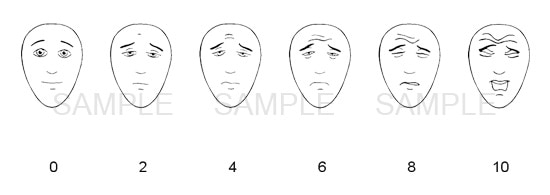Faces Pain Scale – Revised (FPS-R)
The Faces Pain Scale – Revised (FPS-R) is a self-report measure of pain intensity developed for children.
The Faces Pain Scale – Revised [1] (FPS-R) is a self-report measure of pain intensity developed for children. It was adapted from the Faces Pain Scale [2] to make it possible to score the sensation of pain on the widely accepted 0-to-10 metric. The scale shows a close linear relationship with visual analog pain scales across the age range of 4-16 years. It is easy to administer and requires no equipment except for the photocopied faces.
The absence of smiles and tears in this scale may be advantageous. It is particularly recommended for use with very young children. Numerical self-rating scales (0-10) can be used with most children older than 8 years of age [3], and behavioral observation scales are required for those unable to provide a self-report.
Using the Faces Pain Scale – Revised (FPS-R)
In the following instructions, say "Hurt" or "Pain," whichever seems right for a particular child:
"These faces show how much something can hurt. This face [point to left-most face] shows no pain. The faces show more and more pain [point to each from left to right] up to this one. [point to right-most face] It shows very much pain. Point to the face that shows how much you hurt [right now]."

Score the chosen face 0, 2, 4, 6, 8, or 10, counting left to right, so "0" equals "No pain" and "10" equals "Very much pain." Do not use words like "happy" and '"sad." This scale is intended to measure how children feel inside, not how their face looks.
> To access the FPS-R and its derivatives (translations and e-versions) for commercial or non-commercial use, please visit Mapi Research Trust to complete a license agreement.
> For clinical, educational, or research purposes, use of the FPS-R is free of charge, and permission for use is not needed, provided that the scale is not modified or altered in any way. Please visit Mapi Research Trust to complete a license agreement.
> For reproduction of the FPS-R in a journal, book, or web page or for any commercial use of the scale, request permission from Mapi Research Trust. A nominal royalty payment may be required. Guidelines for captioning and reproduction of the scale will be provided with our response to the permission request.
DOWNLOAD FPS-R
Download the Faces Pain Scale – Revised (FPS-R)
No permission is required for clinical, educational, or research use of the FPS-R, provided that it is not modified or altered in any way. To access the FPS-R and its derivatives (translations and e-versions) for commercial or non-commercial use, please visit Mapi Research Trust to complete a license agreement.
For reproduction of the FPS-R in a journal, book, or web page, or for any commercial use of the scale, request permission here: FPS-R permission request. Any alterations, modifications, additions, or other changes to the FPS-R must be approved by IASP before permission for use will be granted. A nominal royalty payment may be required. Guidelines for captioning and reproduction of the scale will be provided with permission.
FPS-R References
- Hicks CL, von Baeyer CL, Spafford P, van Korlaar I, Goodenough B. The Faces Pain Scale - Revised: Toward a common metric in pediatric pain measurement. Pain, 2001;93:173-183.
- Bieri D, Reeve R, Champion GD, Addicoat L, Ziegler J. The Faces Pain Scale for the self-assessment of the severity of pain experienced by children: Development, initial validation and preliminary investigation for ratio scale properties. Pain, 1990;41:139-150.
- von Baeyer CL. Numerical Rating Scale (NRS) or Verbal Numerical Scale (VNS) for self-report of pain intensity in children.
- Tomlinson D, von Baeyer CL, Stinson JN, Sung L. A systematic review of faces scales for the self-report of pain intensity in children. Pediatrics, 2010;126(5):e1168-1198.
- Spagrud LJ, Piira T, von Baeyer CL. Children's self-report of pain intensity: The Faces Pain Scale - Revised. American Journal of Nursing, 2003;103(12):62-64.
- Tsze DS, von Baeyer CL, Bulloch B, Dayan PS. Validation of self-report pain scales in children. Pediatrics. 2013 Oct;132(4):e971-9. doi: 10.1542/peds.2013-1509. Epub 2013 Sep 2.
- Tsze DS, Hirschfeld G, von Baeyer CL, Bulloch B, Dayan PS. Clinically significant differences in acute pain measured on self-report pain scales in children. Acad Emerg Med. 2015 Apr;22(4):415-22. doi: 10.1111/acem.12620. Epub 2015 Mar 13.
- Tsze DS, Hirschfeld G, Dayan PS, Bulloch B, von Baeyer CL. Defining No Pain, Mild, Moderate, and Severe Pain Based on the Faces Pain Scale-Revised and Color Analog Scale in Children With Acute Pain. Pediatr Emerg Care. 2016 May 25.


